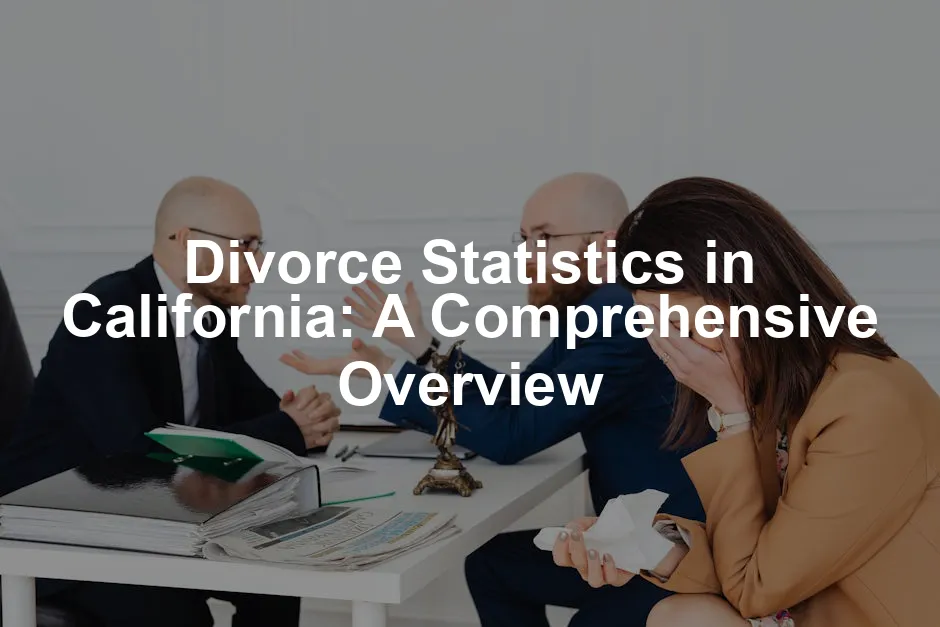Introduction
Divorce is a life event that many people experience. It’s often filled with a whirlwind of emotions, legal battles, and, let’s be honest, a lot of paperwork. In California, where sunshine meets skyscrapers, divorce seems almost as common as beach days. Understanding divorce statistics is crucial. It sheds light on societal trends, helps individuals make informed decisions, and offers insights into the dynamics of marriage today.
California’s divorce statistics are particularly interesting to look at. They not only reflect personal stories but also highlight broader societal shifts. By analyzing these numbers, we can gauge the health of marriages in the state.
In this article, we’ll explore current divorce rates, historical trends, demographics of divorcees, and regional variations across California. We’ll also delve into the factors influencing these rates and why understanding these statistics is vital for anyone contemplating marriage or divorce. So, let’s jump right into the numbers!
Current Divorce Statistics in California
Overview of California Divorce Rates
As of 2024, California’s divorce rate stands at roughly 8.9%. This translates to about 5.88 divorces per 1,000 residents. Surprisingly, this figure places California among the states with lower divorce rates, contradicting popular beliefs that the Golden State is a hub of broken marriages. For context, the national average hovers around 10%, indicating that California couples fare slightly better than their counterparts in other states.
Looking back, divorce rates in California have been on a decline since their peak in the late 1980s. In 2014, the rate was about 9.8%. Since then, it’s gradually decreased, coinciding with a drop in marriage rates as well. Many couples are opting to cohabitate rather than tie the knot.
Interestingly, the average marriage lasts about 8.9 years before hitting the divorce courts. This number suggests that many couples may face challenges after the initial spark fades, leading to a reassessment of their relationships.

Demographics of Divorce
Diving into the demographics, divorce in California paints a varied picture. Women tend to lead the divorce statistics, with approximately 10.7% reporting they have been divorced, compared to 7.4% of men. Age plays a significant role too. Couples marrying in their early twenties are statistically more likely to divorce, while those who wait until their late twenties or thirties often have more stable unions.
Educational attainment also influences divorce rates. Those with higher education levels generally report lower rates of divorce. This correlation may arise from improved communication skills and financial stability, factors that contribute to healthier relationships. For those looking to deepen their understanding of relationships, consider picking up The Five Love Languages. It’s a great resource for expressing heartfelt commitment to your partner.
In terms of marital longevity, the average length of marriage before divorce is about 8.9 years. This statistic indicates that many couples may find themselves at a crossroads after several years of shared life experiences.
Regional Variations
California is a diverse state, and this diversity extends to divorce rates across its counties and cities. For instance, places like Shasta County report divorce rates as high as 13.8%, while cities like Fremont boast some of the lowest rates in the state, thanks to socio-economic factors that promote marital stability. If you find yourself needing to understand the legalities of your situation better, The Complete Guide to Divorce Law can be a valuable asset.
Los Angeles County, with its bustling lifestyle and unique culture, mirrors the state’s average but has its own quirks. High divorce rates may correlate with the fast-paced lives of Angelenos, where societal influences and pressures can strain relationships.
In contrast, more rural areas might display different divorce dynamics. Factors such as economic hardship and limited access to resources can contribute to higher rates of divorce.
Understanding these regional variations helps us grasp the complexities of divorce in California, providing a clearer picture of how factors like geography, culture, and socio-economic status influence marital outcomes.
With this overview, we can see that California’s divorce landscape is multifaceted. By recognizing the trends and demographics, individuals can better navigate their marital journeys, whether they are contemplating marriage or facing the challenges of divorce.

Factors Influencing Divorce Rates
Divorce rates in California are influenced by a multitude of factors. Understanding these can provide insights into why marriages succeed or fail. Let’s break it down into socioeconomic factors, age and timing, cultural influences, and legal factors that shape the landscape of divorce in the Golden State.
Socioeconomic Factors
Income and education levels are crucial indicators of divorce likelihood. Generally, individuals with higher education tend to have lower divorce rates. Education often leads to better communication skills and financial stability, which are vital for marital harmony. In California, where the cost of living is notably high, financial stress can be a marriage’s worst enemy. Couples grappling with financial issues often face increased tension, leading to conflicts that may culminate in divorce.
Consider this: a 2023 study revealed that about one-third of divorcing couples cited financial troubles as a significant reason for their separation. When money becomes tight, the strain can make it difficult for couples to maintain a united front. Thus, economic conditions play a pivotal role in marriage stability. To help manage finances better, consider The Total Money Makeover. It’s a proven plan for achieving financial fitness!

Age and Timing
The average age of marriage in California has been steadily climbing. Currently, men typically marry at around 30, while women marry at about 28. This trend towards later marriages correlates with lower divorce rates. When individuals marry later, they tend to have a clearer sense of self and greater life experience, which can contribute to healthier relationships.
Delayed marriages also have their perks. Couples who wait to tie the knot often possess better emotional maturity and financial security. This maturity can lead to more stable unions. Younger couples, on the other hand, marrying in their early twenties, face a higher likelihood of divorce. With the average marriage lasting around 8.9 years before ending, it’s clear that timing matters in the decision to marry.
Cultural Influences
California’s rich tapestry of cultures significantly impacts marriage and divorce dynamics. The state is home to diverse backgrounds, each with unique views on relationships. Cultural and religious beliefs can shape attitudes towards marriage and divorce, influencing decisions to stay together or separate. For example, in some cultures, divorce may carry a stigma, leading individuals to remain in unhappy marriages.
The melting pot nature of California means that couples often have different expectations about marital roles, parenting, and conflict resolution. These differences can lead to misunderstandings and strain on relationships, making it vital for couples to communicate openly about their values and expectations. To enhance communication skills, consider reading Emotional Intelligence 2.0. It’s a fantastic resource for improving your interpersonal skills!

Legal Factors
California’s legal framework surrounding divorce plays a significant role in its divorce rates. The state operates under no-fault divorce laws, meaning that neither party has to prove wrongdoing to file for divorce. This simplified process can make the decision to divorce easier, as couples don’t have to navigate the complexities of proving fault.
Additionally, California follows community property laws. This means that assets acquired during the marriage are divided equally upon divorce, unless otherwise agreed. Such laws can impact how couples approach marriage—understanding that financial ties are equally shared may encourage caution in entering marriage, influencing the decision to delay or avoid it altogether. For those interested in understanding the mediation process, Divorce Mediation: A Guide to the Process and Benefits is a great starting point.
In conclusion, the interplay of socioeconomic conditions, age, cultural norms, and legal frameworks shapes California’s divorce landscape. Understanding these factors can empower individuals to make informed choices about their relationships, potentially leading to healthier marriages. By recognizing the elements at play, couples can work towards fostering stronger, more resilient partnerships.

Common Reasons for Divorce in California
Overview of Reasons
Divorce is a complex issue that often stems from a variety of factors. In California, several common reasons frequently surface when people discuss their marital breakdowns. The most cited reasons include:
- Infidelity
- Financial issues
- Communication problems
- Incompatibility
- Substance abuse
- Domestic violence
- Growing apart
Each of these reasons paints a picture of the challenges couples face, leading them to seek divorce as a solution. If you’re looking for guidance on navigating these emotional challenges, The Mindful Way Through Divorce can provide helpful strategies for navigating these emotional challenges.

Detailed Analysis of Key Factors
Infidelity
Ah, infidelity—the classic plot twist! It’s like a soap opera, but unfortunately, it’s real life for many couples. In California, infidelity is one of the leading causes of divorce. Trust is the bedrock of any relationship, and when that trust is shattered, rebuilding can feel impossible. Studies show that many couples struggle to move past the betrayal, leading to separation. Infidelity can arise from a variety of motives, including emotional dissatisfaction or mere opportunity. Sadly, this breach often signals deeper incompatibilities within the marriage.

Financial Issues
Money talks, but sometimes it yells! Financial issues are a primary source of conflict in many marriages. In a state like California, with its high cost of living, financial stress can escalate quickly. Disagreements over spending habits, debt management, or differing financial goals can lead to animosity. Experts suggest that nearly one-third of divorcing couples cite financial troubles as a significant reason for their split. When bills pile up and financial burdens weigh heavily, couples may find themselves at odds, making divorce seem like the only viable option. To help with financial management, check out Divorce and Money: How to Make the Best Financial Decisions During Divorce. It’s a great resource for navigating the financial aspects of separation.

Communication Problems
You’ve probably heard the saying, “It’s not what you say, it’s how you say it.” Well, poor communication can lead to misunderstandings and conflicts that spiral out of control. In California, many couples report that they simply don’t know how to talk to each other anymore. Whether it’s avoiding difficult conversations or misinterpreting intentions, these communication breakdowns can create a rift. When couples fail to express their feelings or listen to each other, resentment can fester. Ultimately, without healthy communication, relationships can deteriorate.

Incompatibility
Sometimes, couples may find they are just not on the same wavelength. Incompatibility can manifest in many forms—differing life goals, values, or lifestyles. As people grow and change, they may realize that their partner no longer aligns with their life vision. In California, where individualism is often celebrated, many choose to pursue their own paths rather than compromise in a relationship. This divergence can lead to a mutual recognition that parting ways is the healthier option, allowing both individuals to thrive in their own unique ways.
Understanding these factors can provide insight into the emotional landscape surrounding divorce in California. Each reason reflects broader societal trends and personal experiences, reminding us that divorce is rarely the result of a single issue. Instead, it’s often the culmination of various challenges that couples face together. Recognizing these common reasons can help individuals navigate their marital journeys, whether they are preventing a breakup or preparing for one.

The Divorce Process in California
Navigating a divorce can feel like trying to dance in a minefield—one wrong step and BOOM! But fear not, California has a clear process to help you avoid those explosive missteps. Here’s what you need to know about the steps involved in filing for divorce in the Golden State.
Steps in the Divorce Process
First things first, before you start packing your bags for a new life, you need to file a petition for divorce. This involves completing and submitting a few forms to the court. The main form is the Petition for Dissolution of Marriage (Form FL-100). You’ll also need to fill out a Summons (Form FL-110). These forms inform your spouse about the divorce proceedings and provide essential details about your marriage.
After filing, you must serve your spouse with copies of these documents. You can’t just shove them in their mailbox and call it a day. You need to have someone over 18, who isn’t involved in the case, deliver them. This process is called “service of process.”
Once your spouse is served, they have 30 days to respond. If they ignore you, congratulations! You can apply for a default judgment. If they do respond, it’s time to negotiate. This could involve mediation, where a neutral third party helps you reach an agreement. It’s like a referee in a match, but hopefully less dramatic.
Now, let’s talk about the waiting period. California has a mandatory six-month waiting period from the time you file your divorce petition until the divorce is finalized. This can feel like an eternity, especially when you’re eager to move on. But don’t worry, this waiting period is designed to give both parties time to reconsider or settle their differences.
You also need to meet residency requirements to file for divorce in California. One spouse must have lived in California for at least six months before filing. Additionally, you must file in the county where either you or your spouse has lived for the past three months. So, if you’re planning to file in Malibu but just moved there last week, you might want to hold off!

Legal Considerations
Now, let’s talk about the elephant in the room: hiring a divorce attorney. In California, navigating the divorce process can be complex, and having a knowledgeable attorney by your side can make a world of difference. A good lawyer will understand the intricacies of California family law, help you with paperwork, and protect your rights during negotiations.
When looking for legal representation, consider a few key factors. First, ensure the attorney specializes in family law. You wouldn’t hire a plumber to perform surgery, right? Look for someone who knows the ins and outs of divorce proceedings.
Next, check their experience. How long have they been practicing? Do they have a good track record in settling disputes? Client testimonials can provide insight into their effectiveness. Finally, consider their communication style. You want someone who listens and responds promptly because, let’s face it, the last thing you need is more stress during this challenging time. If you’re still feeling overwhelmed, The Divorce Recovery Guide can provide a step-by-step plan for moving forward.
Understanding these steps and legal considerations will help you approach your divorce with greater clarity and confidence. Remember, while it may feel overwhelming, you are not alone in this journey. With the right information and support, you can navigate the process and come out stronger on the other side.

FAQs
What is the current divorce rate in California?
As of 2024, California’s divorce rate is approximately 8.9%. This means about 5.88 divorces occur per 1,000 residents, reflecting a gradual decline in recent years.
How long does it take to get a divorce in California?
Divorce in California has a mandatory waiting period of six months from the date of filing before it can be finalized. However, the overall duration may vary depending on the complexity of the case.
Is California a 50/50 divorce state?
Yes, California is a 50/50 divorce state. This means that assets acquired during the marriage are generally divided equally unless a prenuptial agreement states otherwise.
What are the residency requirements for filing for divorce in California?
To file for divorce in California, one spouse must have lived in the state for at least six months and in the county where the divorce is filed for the last three months.
Can a spouse refuse a divorce in California?
In California, a spouse cannot refuse a divorce. If one spouse files, the process can continue regardless of the other spouse’s willingness. However, the non-filing spouse has 30 days to respond to the divorce petition.
What are the most common causes of divorce in California?
Common causes of divorce in California include financial issues, infidelity, communication problems, and growing apart. Each of these factors can significantly impact the stability of a marriage and contribute to the decision to separate.
Please let us know what you think about our content by leaving a comment down below!
Thank you for reading till here 🙂
All images from Pexels




